Carbonaceous Materials in the Fault Zone of the Longmenshan Fault Belt: 2. Characterization of Fault Gouge from Deep Drilling and Implications for Fault Maturity
Abstract
1. Introduction
2. Materials and Methods
3. Results
3.1. XRD Analysis
3.2. RSCM
4. Discussion and Conclusions
Author Contributions
Funding
Acknowledgments
Conflicts of Interest
References
- Sibson, R.H. Thickness of the seismic slip zone. Seismol. Soc. 2003, 93, 1169–1178. [Google Scholar] [CrossRef]
- Goldsby, D.L.; Tullis, T.E. Low frictional strength of quartz rocks at subseismic slip rates. Geophys. Res. Lett. 2002, 29, 1844. [Google Scholar] [CrossRef]
- Di Toro, G.; Hirose, T.; Nielsen, S.; Pennacchioni, G.; Shimamoto, T. Natural and experimental evidence of melt lubrication of faults during earthquakes. Science 2006, 311, 647–649. [Google Scholar] [CrossRef] [PubMed]
- Di Toro, G.; Goldsby, D.L.; Tullis, T.E. Friction falls towards zero in quartz rock as slip velocity approaches seismic rates. Nature 2004, 427, 436–439. [Google Scholar] [CrossRef] [PubMed]
- Han, R.; Shimamoto, T.; Hirose, T.; Ree, J.-H.; Ando, J. Ultralow friction of carbonate faults caused by thermal decomposition. Science 2007, 316, 878–881. [Google Scholar] [CrossRef] [PubMed]
- Di Toro, G.; Han, R.; Hirose, T.; De Paola, N.; Nielsen, S.; Mizoguchi, K.; Ferri, F.; Cocco, M.; Shimamoto, T. Fault lubrication during earthquakes. Nature 2011, 471, 494–498. [Google Scholar] [CrossRef] [PubMed]
- Niemeijer, A.; Di Toro, G.; Griffith, W.A.; Bistacchi, A.; Smith, S.A.F.; Nielsen, S. Inferring earthquake physics and chemistry using an integrated field and laboratory approach. J. Struct. Geol. 2012, 39, 2–36. [Google Scholar] [CrossRef]
- Sibson, R.H. Generation of pseudotachylyte by ancient seismic faulting. Geophys. J. R. Astron. Soc. 1975, 43, 775–794. [Google Scholar] [CrossRef]
- Tsutsumi, A.; Shimamoto, T. High-velocity frictional properties of gabbro. Geophys. Res. Lett. 1997, 24, 699–702. [Google Scholar] [CrossRef]
- Di Toro, G.; Pennacchioni, G.; Nielsen, S.; Eiichi, F. Pseudotachylytes and earthquake source mechanics. In International Geophysics; Fukuyama, E., Ed.; Academic Press: Cambridge, MA, USA, 2009; Volume 94, pp. 87–133. [Google Scholar]
- Kuo, L.-W.; Song, S.-R.; Yeh, E.C.; Chen, H.F.; Si, J. Clay mineralogy and geochemistry investigations in the host rocks of the Chelungpu fault, Taiwan: Implication for faulting mechanism. J. Asian Earth Sci. 2012, 59, 208–218. [Google Scholar] [CrossRef]
- Rowe, C.D.; Fagereng, A.; Miller, J.A.; Mapani, B. Signature of coseismic decarbonation in dolomitic fault rocks of the Naukluft Thrust, Namibia. Earth Planet. Sci. Lett. 2012, 333–334, 200–210. [Google Scholar] [CrossRef]
- Kirkpatrick, J.D.; Rowe, C.D.; White, J.C.; Brodsky, E.E. Silica gel formation during fault slip: Evidence from the rock record. Geology 2013, 41, 1015–1018. [Google Scholar] [CrossRef]
- Smith, S.A.F.; Di Toro, G.; Kim, S.; Ree, J.-H.; Nielsen, S.; Billi, A.; Spiess, R. Coseismic recrystallization during shallow earthquake slip. Geology 2013, 41, 63–66. [Google Scholar] [CrossRef]
- Evans, J.P.; Prante, M.R.; Janecke, S.U.; Ault, A.K.; Newell, D. Hot faults: Iridescent slip surfaces with metallic luster document high-temperature ancient seismicity in the Wasatch fault zone, Utah, USA. Geology 2014, 42, 623–626. [Google Scholar] [CrossRef]
- Kuo, L.-W.; Song, S.-R.; Suppe, J.; Yeh, E.C. Fault mirrors in seismically active fault zones: A fossil of small earthquakes at shallow depths. Geophys. Res. Lett. 2016, 43, 1950–1959. [Google Scholar] [CrossRef]
- Xu, X.; Wen, W.; Yu, G.; Klinger, Y.; Hubbard, J.; Shaw, J. Coseismic reverse- and oblique-slip surface faulting generated by the 2008 Mw 7.9 Wenchuan earthquake, China. Geology 2009, 37, 515–518. [Google Scholar] [CrossRef]
- Xu, C.; Liu, Y.; Wen, Y.; Wang, R. Coseismic slip distribution of the 2008 Mw 7.9 Wenchuan earthquake from Join Inversion of GPS and InSAR data. Seismol. Soc. 2010, 100, 2736–2749. [Google Scholar] [CrossRef]
- Li, H.; Wang, H.; Xu, Z.; Si, J.; Pei, J.; Li, T.; Huang, Y.; Song, S.-R.; Kuo, L.-W.; Sun, Z.; et al. Characteristics of the fault-related rocks, fault zones and the principal slip zone in the Wenchuan earthquake Fault Scientific Drilling Hole-1 (WFSD-1). Tectonophysics 2013, 584, 23–42. [Google Scholar] [CrossRef]
- Kuo, L.-W.; Li, H.; Smith, S.A.F.; Di Toro, G.; Suppe, J.; Song, S.-R.; Nielsen, S.; Sheu, H.-S.; Si, J. Gouge graphitization and dynamic fault weakening during the 2008 Mw 7.9 Wenchuan earthquake. Geology 2014, 42, 47–50. [Google Scholar] [CrossRef]
- Kuo, L.-W.; Di Felice, F.; Spagnuolo, E.; Di Toro, G.; Song, S.-R.; Aretusini, S.; Li, H.; Suppe, J.; Si, J.; Wen, C.-Y. Fault gouge graphitization as evidence of past seismic slip. Geology 2017, 45, 979–982. [Google Scholar] [CrossRef]
- Ross, J.V.; Bustin, R.M. The role of strain energy in creep graphitization of anthracite. Nature 1990, 343, 58–60. [Google Scholar] [CrossRef]
- Si, J.; Li, H.; Kuo, L.-W.; Pei, J.; Song, S.-R.; Wang, H. Clay mineral anomalies in the Yingxiu-Beichuan fault zone from the WFSD-1 drilling core and its implication for the faulting mechanism during the 2008 Wenchuan earthquake (Mw 7.9). Tectonophysics 2014, 619–620, 171–178. [Google Scholar] [CrossRef]
- Li, H.; Xue, L.; Brodsky, E.E.; Mori, J.J.; Fulton, R.M.; Wang, H.; Kano, Y.; Yun, K.; Harris, R.N.; Gong, Z.; et al. Long-term temperature records following the Mw 7.9 Wencuhan (China) earthquake are consistent with low friction. Geology 2015, 43, 163–166. [Google Scholar] [CrossRef]
- Sibson, R.H. Fault rocks and fault mechanisms. J. Geol. Soc. Lond. 1977, 133, 191–213. [Google Scholar] [CrossRef]
- Chester, F.M.; Evans, J.P.; Biegel, R.L. Internal structure and weakening mechanisms of the San Andreas fault. J. Geophys. Res. 1993, 98, 771–786. [Google Scholar] [CrossRef]
- Kuo, L.-W.; Song, S.-R.; Huang, L.; Yeh, E.C.; Chen, H.F. Temperature estimates of coseismic heating in clay-rich fault gouges, the Chelungpu fault zone, Taiwan. Tectonophysics 2011, 502, 315–327. [Google Scholar] [CrossRef]
- Wopenka, B.; Pasteris, J.D. Structural characterization of kerogens to granulite-facies graphite: Applicability of Raman microprobe spectroscopy. Am. Mineral. 1993, 78, 533–557. [Google Scholar]
- Beyssac, O.; Rouzaud, J.N.; Goffé, B.; Brunet, F.; Chopin, C. Graphitization in a high-pressure, low-temperature metamorphic gradient: A Raman microspectroscopy and HRTEM study. Contrib. Mineral. Petrol. 2002, 143, 19–31. [Google Scholar] [CrossRef]
- Beyssac, O.; Goffé, B.; Petitet, J.P.; Froigneux, E.; Moreau, M.; Rouzaud, J.N. On the characterization of disordered and heterogeneous carbonaceous materials by Raman spectroscopy. Spectrochim. Acta Part A 2003, 59, 2267–2276. [Google Scholar] [CrossRef]
- Sadezky, A.; Muckenhuber, H.; Grothe, H.; Niessner, R.; Poschl, U. Raman microspectroscopy of soot and related carbonaceous materials: Spectral analysis and structural information. Carbon 2005, 43, 1731–1742. [Google Scholar] [CrossRef]
- Furuichi, H.; Ujiie, K.; Kouketsu, Y.; Saito, T.; Tsutsumi, A.; Wallis, S. Vitrinite reflectance and Raman spectra of carbonaceous material as indicators of frictional heating on faults: Constraints from friction experiments. Earth Planet. Sci. Lett. 2015, 424, 191–200. [Google Scholar] [CrossRef]
- Lunsdorf, N.K.; Dunkl, I.; Schmidt, B.; Rantitsch, G.; von Eynatten, H. Towards a higher comparability of geothermometric data obtained by Raman spectroscopy of carbonaceous material. Part 1: Evaluation of biasing factors. Geostand. Geoanal. Res. 2014, 38, 73–94. [Google Scholar] [CrossRef]
- Lunsdorf, N.K.; Dunkl, I.; Schmidt, B.; Rantitsch, G.; von Eynatten, H. Towards a higher comparability of geothermometric data obtained by Raman spectroscopy of carbonaceous material. Part 2: A revised geothermometer. Geostand. Geoanal. Res. 2017, 41, 593–612. [Google Scholar] [CrossRef]
- Kuo, L.-W.; Song, S.-R.; Yeh, E.-C.; Chen, H.-F. Clay mineral anomalies in the fault zone of the Chelungpu Fault, Taiwan, and their implications. Geophys. Res. Lett. 2009, 36, L18306. [Google Scholar] [CrossRef]
- Ferrari, A.C.; Robertson, J. Interpretation of Raman spectra of disordered and amorphous carbon. Phys. Rev. 2000, 61, 14095–14107. [Google Scholar] [CrossRef]
- Chen, J.; Niemeijer, A.; Yao, L.; Ma, S. Water vaporization promotes coseismic fluid pressurization and buffers temperature rise. Geophys. Res. Lett. 2017, 44, 2177–2185. [Google Scholar] [CrossRef]
- Faulkner, D.R.; Lewis, A.C.; Rutter, E.H. On the internal structure and mechanics of large strike-slip fault zones: Field observations of the Carboneras fault in southeastern Spain. Tectonophysics 2003, 367, 235–251. [Google Scholar] [CrossRef]
- Rouzaud, J.-N.; Oberlin, A. Structure, microtexture, and optical properties of anthracene and saccharose-based carbons. Carbon 1989, 27, 517–529. [Google Scholar] [CrossRef]
- Rumble, D. Hydrothermal graphitic carbon. Element 2014, 10, 427–433. [Google Scholar] [CrossRef]
- Galvez, M.E.; Beyssac, O.; Martinez, I.; Benzerara, K.; Chaduteau, C.; Malvoisin, B.; Malavieille, J. Graphite formation by carbonate reduction during subduction. Nat. Geosci. 2013, 6, 473–477. [Google Scholar] [CrossRef]
- Zheng, Y.; Li, H.; Gong, Z. Geothermal study at the Wenchuan earthquake Fault Scientific Drilling project-hole 1 (WFSD-1): Borehole temperature, thermal conductivity, and well log data. J. Asian Earth Sci. 2016, 117, 23–32. [Google Scholar] [CrossRef]
- Oohashi, K.; Hirose, T.; Shimamoto, T. Graphite as a lubricating agent in fault zones: An insight from low- to high-velocity friction experiments on a mixed graphite-quartz gouge. J. Geophys. Res. 2013, 118, 2067–2084. [Google Scholar] [CrossRef]
- Erdemir, A.; Donnet, C. Tribology of diamond-like carbon films: Recent progress and future prospects. J. Phys. D Appl. Phys. 2006, 39, 311–327. [Google Scholar] [CrossRef]
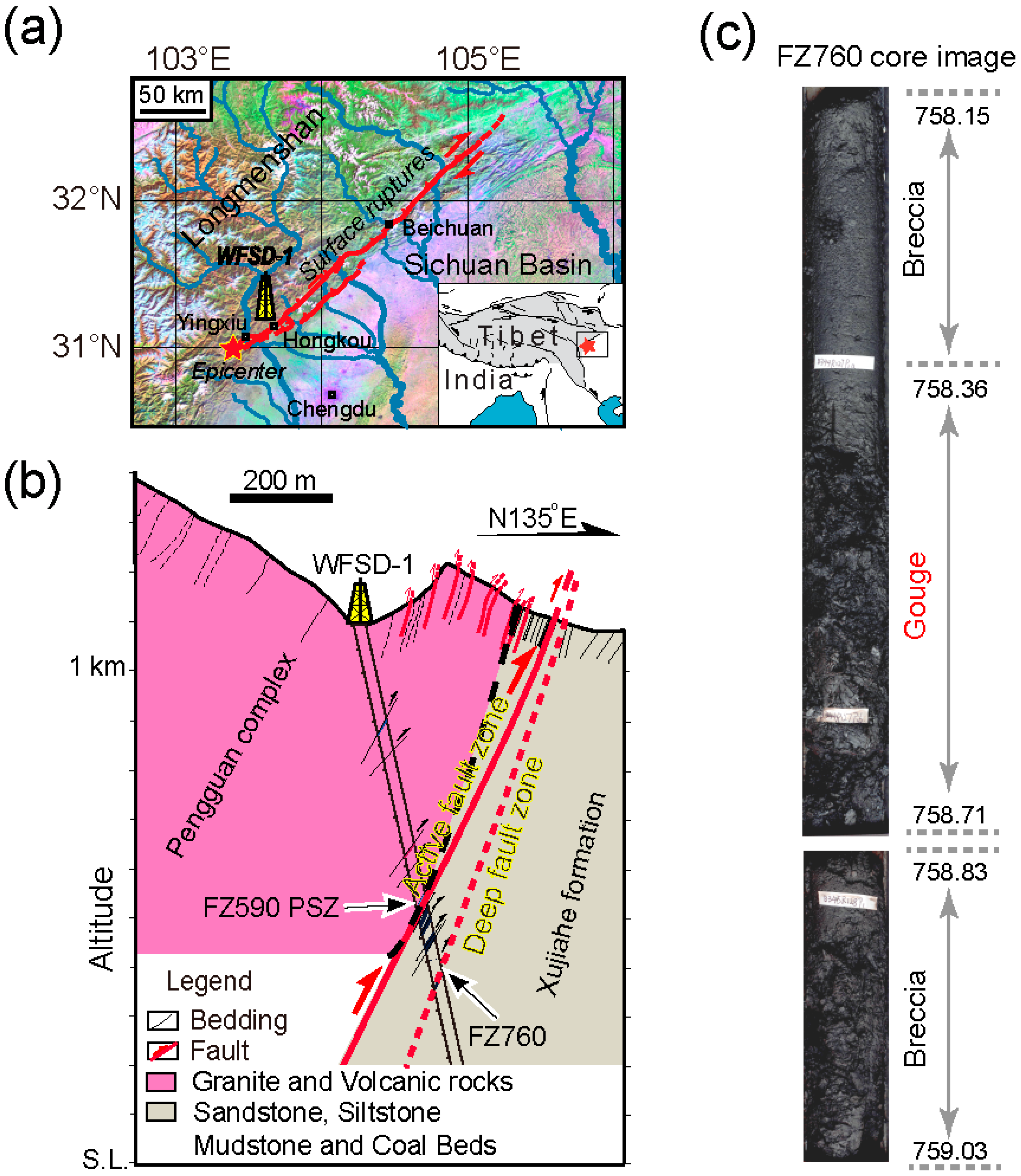
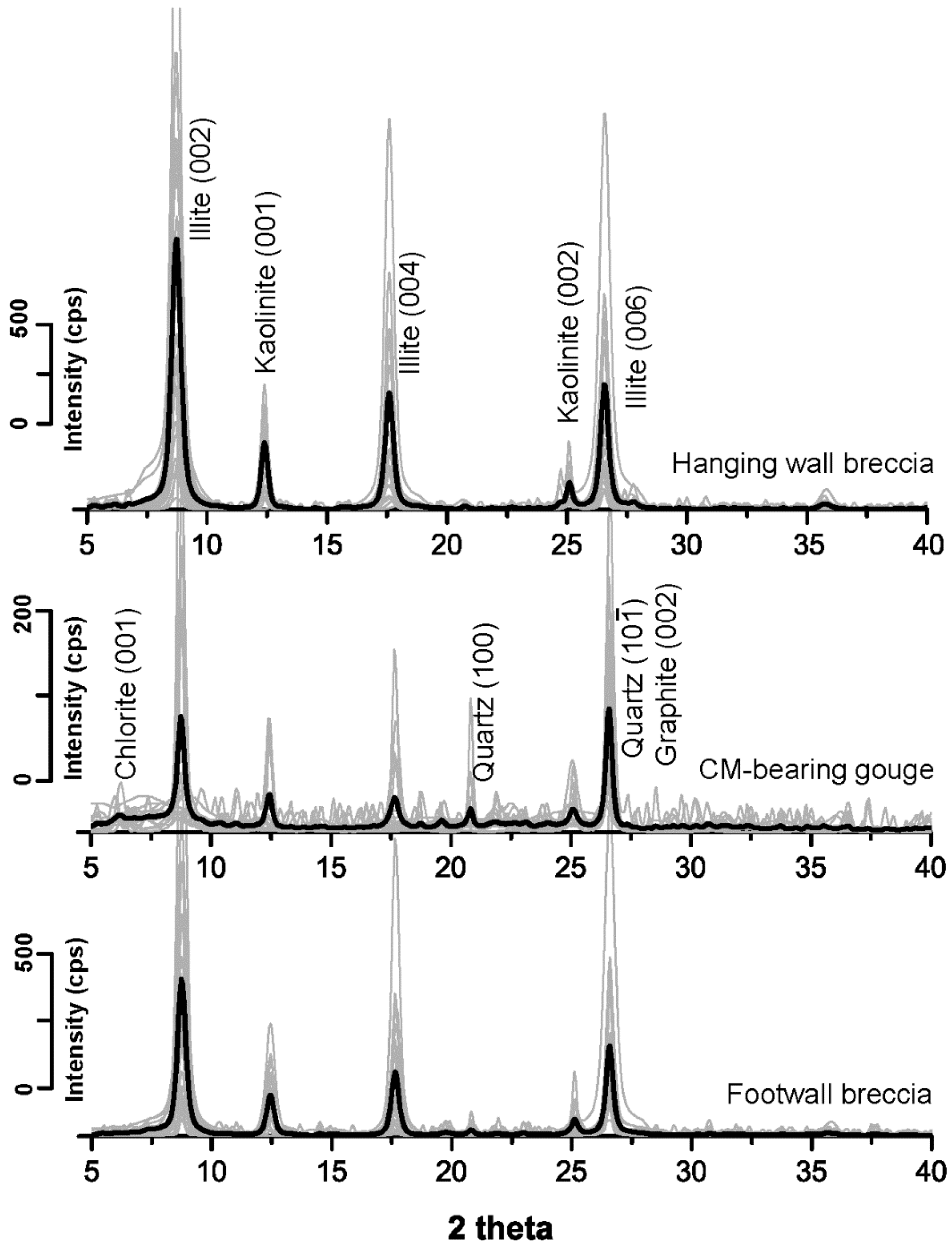
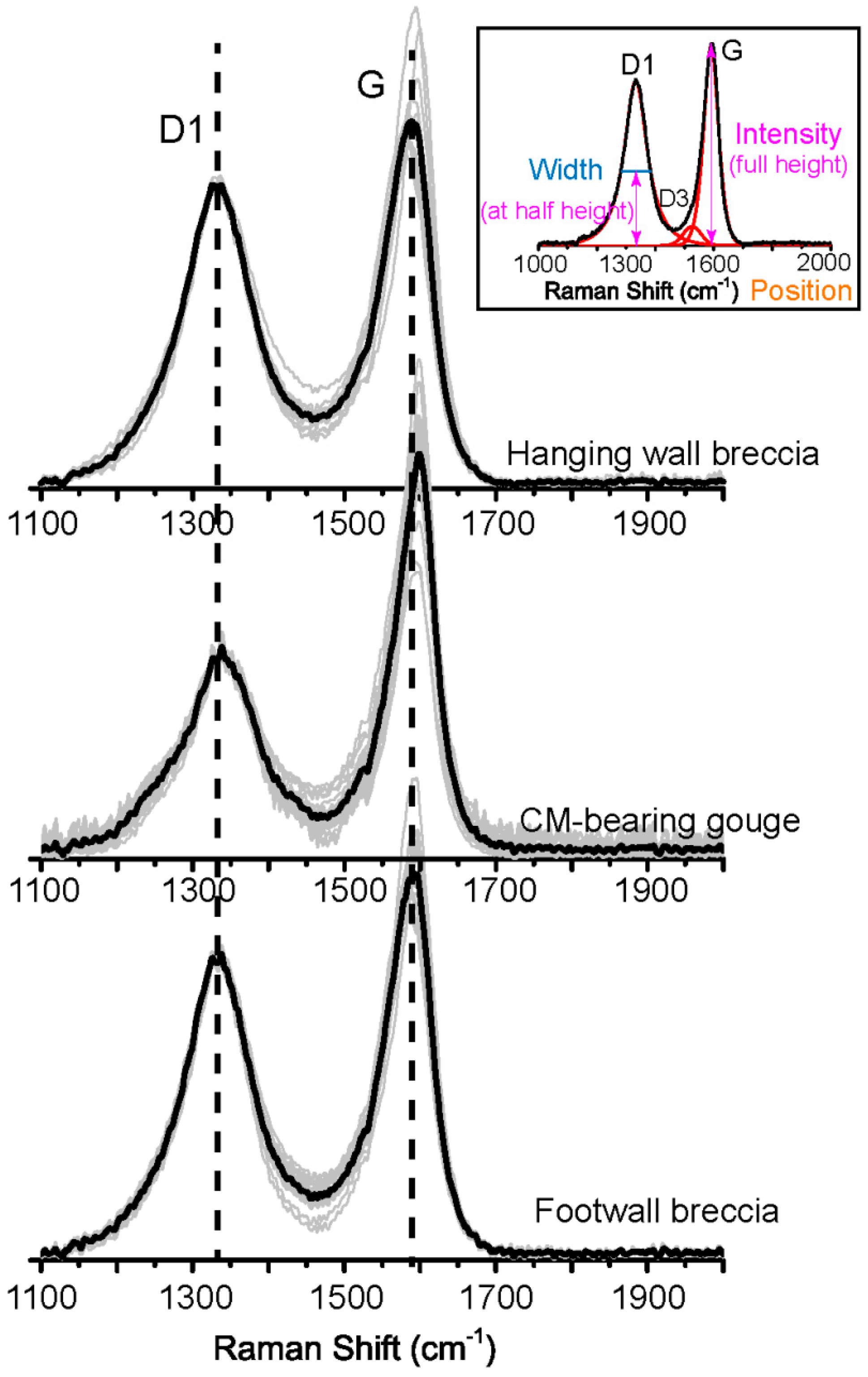
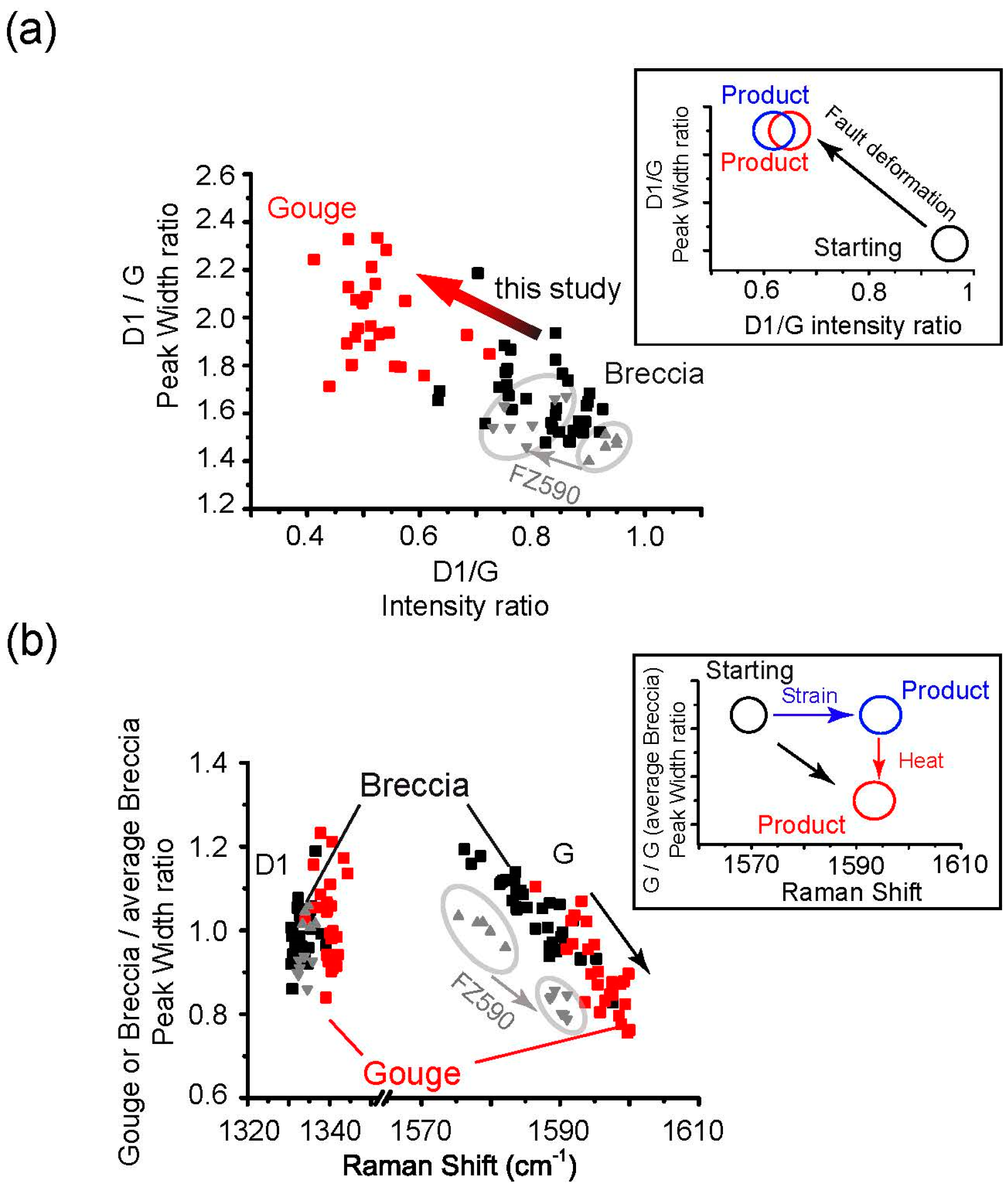
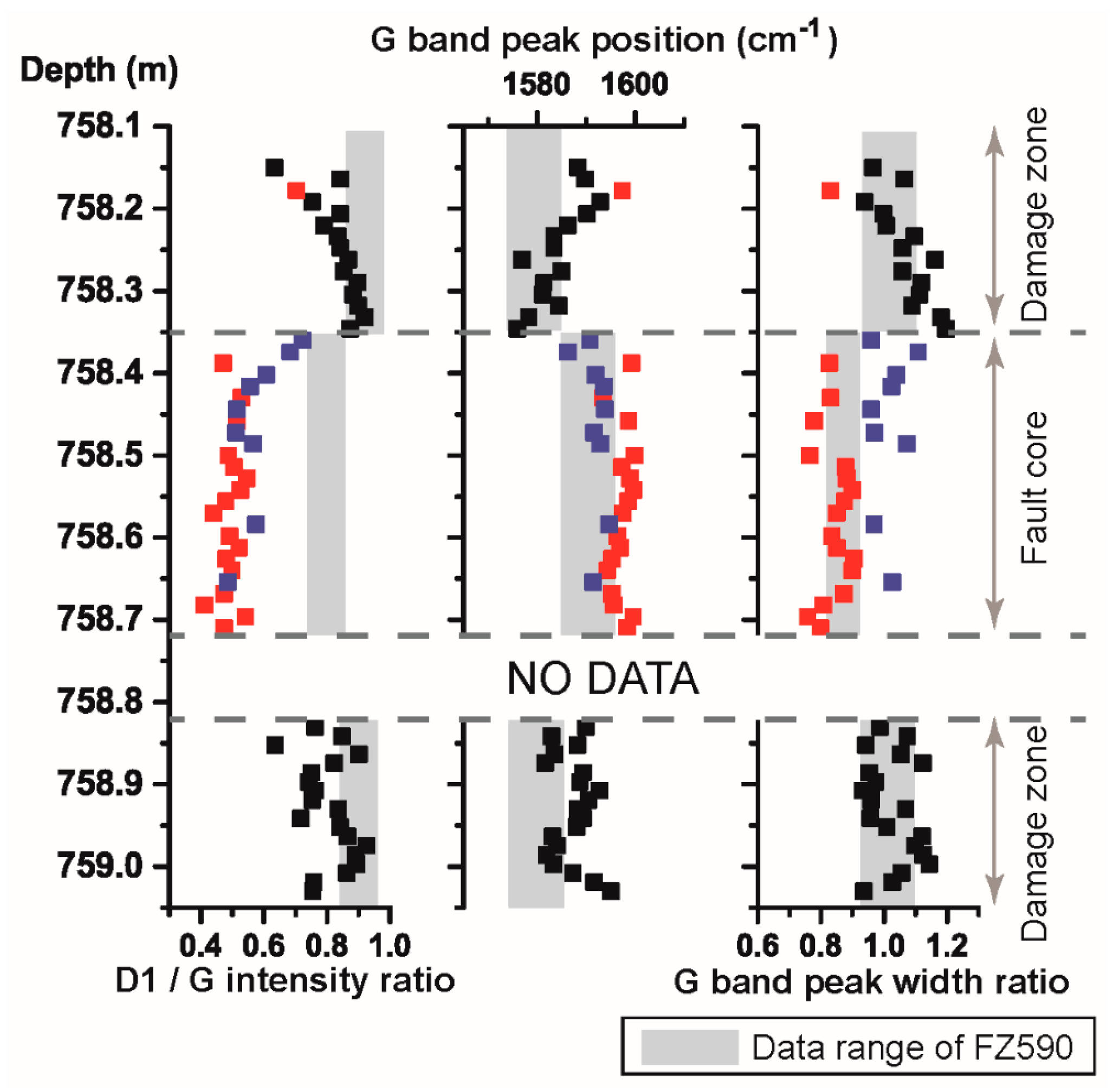
| Type | Depth (m) | D1/G Intensity (Error Estimate ±0.07) | D1/G Width Ratio (Error Estimate ±0.10) | Peak Position (cm−1) | Gouge or Breccia/Average Breccia | ||
|---|---|---|---|---|---|---|---|
| D1 | G | D1 | G | ||||
| Breccia | 758.15 | 0.63 | 1.66 | 1334 | 1588 | 0.92 | 0.97 |
| Breccia | 758.16 | 0.84 | 1.94 | 1336 | 1590 | 1.19 | 1.06 |
| Breccia | 758.18 | 0.70 | 2.19 | 1335 | 1597 | 1.05 | 0.83 |
| Breccia | 758.19 | 0.75 | 1.77 | 1334 | 1593 | 0.96 | 0.94 |
| Breccia | 758.21 | 0.84 | 1.82 | 1334 | 1590 | 1.05 | 1.00 |
| Breccia | 758.22 | 0.79 | 1.66 | 1331 | 1586 | 0.97 | 1.01 |
| Breccia | 758.23 | 0.83 | 1.56 | 1330 | 1583 | 0.99 | 1.10 |
| Breccia | 758.25 | 0.84 | 1.62 | 1330 | 1583 | 0.99 | 1.06 |
| Breccia | 758.26 | 0.87 | 1.48 | 1331 | 1577 | 1.00 | 1.16 |
| Breccia | 758.28 | 0.85 | 1.77 | 1332 | 1585 | 1.08 | 1.06 |
| Breccia | 758.29 | 0.90 | 1.63 | 1332 | 1581 | 1.06 | 1.12 |
| Breccia | 758.30 | 0.88 | 1.57 | 1330 | 1581 | 1.01 | 1.11 |
| Breccia | 758.32 | 0.90 | 1.65 | 1333 | 1584 | 1.04 | 1.09 |
| Breccia | 758.33 | 0.92 | 1.52 | 1332 | 1578 | 1.04 | 1.18 |
| Breccia | 758.35 | 0.87 | 1.53 | 1332 | 1576 | 1.06 | 1.2 |
| Gouge | 758.36 | 0.72 | 1.85 | 1334 | 1591 | 1.02 | 0.96 |
| Gouge | 758.37 | 0.68 | 1.93 | 1337 | 1586 | 1.24 | 1.11 |
| Gouge | 758.39 | 0.47 | 1.89 | 1340 | 1599 | 0.90 | 0.83 |
| Gouge | 758.40 | 0.61 | 1.76 | 1339 | 1592 | 1.06 | 1.04 |
| Gouge | 758.42 | 0.56 | 1.80 | 1339 | 1594 | 1.06 | 1.02 |
| Gouge | 758.43 | 0.53 | 1.93 | 1339 | 1593 | 0.93 | 0.83 |
| Gouge | 758.44 | 0.51 | 1.97 | 1337 | 1594 | 1.09 | 0.96 |
| Gouge | 758.46 | 0.51 | 2.21 | 1340 | 1599 | 1.00 | 0.78 |
| Gouge | 758.47 | 0.51 | 1.88 | 1336 | 1592 | 1.06 | 0.97 |
| Gouge | 758.49 | 0.57 | 1.79 | 1340 | 1593 | 1.11 | 1.07 |
| Gouge | 758.50 | 0.49 | 2.07 | 1341 | 1600 | 0.92 | 0.76 |
| Gouge | 758.51 | 0.51 | 2.09 | 1340 | 1597 | 1.06 | 0.88 |
| Gouge | 758.53 | 0.54 | 1.94 | 1341 | 1599 | 0.99 | 0.88 |
| Gouge | 758.54 | 0.52 | 2.33 | 1340 | 1600 | 1.21 | 0.90 |
| Gouge | 758.56 | 0.48 | 1.80 | 1340 | 1599 | 0.91 | 0.87 |
| Gouge | 758.57 | 0.44 | 1.71 | 1339 | 1597 | 0.84 | 0.85 |
| Gouge | 758.58 | 0.57 | 2.07 | 1336 | 1595 | 1.16 | 0.97 |
| Gouge | 758.60 | 0.49 | 1.96 | 1341 | 1596 | 0.94 | 0.83 |
| Gouge | 758.61 | 0.52 | 2.14 | 1339 | 1597 | 1.05 | 0.85 |
| Gouge | 758.63 | 0.48 | 1.80 | 1339 | 1595 | 0.94 | 0.90 |
| Gouge | 758.64 | 0.50 | 2.06 | 1339 | 1594 | 1.07 | 0.90 |
| Gouge | 758.65 | 0.49 | 1.92 | 1344 | 1591 | 1.14 | 1.03 |
| Gouge | 758.67 | 0.47 | 2.33 | 1343 | 1595 | 1.18 | 0.87 |
| Gouge | 758.68 | 0.41 | 2.24 | 1339 | 1596 | 1.05 | 0.81 |
| Gouge | 758.70 | 0.54 | 2.28 | 1340 | 1600 | 1.00 | 0.76 |
| Gouge | 758.71 | 0.47 | 2.13 | 1340 | 1598 | 0.98 | 0.80 |
| Breccia | 758.83 | 0.76 | 1.62 | 1334 | 1590 | 0.92 | 0.99 |
| Breccia | 758.84 | 0.85 | 1.52 | 1331 | 1583 | 0.95 | 1.07 |
| Breccia | 758.85 | 0.63 | 1.69 | 1330 | 1588 | 0.92 | 0.94 |
| Breccia | 758.86 | 0.90 | 1.68 | 1332 | 1584 | 1.03 | 1.05 |
| Breccia | 758.87 | 0.82 | 1.48 | 1332 | 1582 | 0.96 | 1.12 |
| Breccia | 758.89 | 0.75 | 1.88 | 1333 | 1589 | 0.96 | 0.97 |
| Breccia | 758.91 | 0.76 | 1.87 | 1335 | 1593 | 1.01 | 0.93 |
| Breccia | 758.92 | 0.75 | 1.72 | 1333 | 1590 | 0.95 | 0.96 |
| Breccia | 758.93 | 0.84 | 1.54 | 1333 | 1588 | 0.95 | 1.07 |
| Breccia | 758.94 | 0.72 | 1.56 | 1330 | 1589 | 0.86 | 0.96 |
| Breccia | 758.95 | 0.84 | 1.59 | 1333 | 1588 | 0.93 | 1.01 |
| Breccia | 758.96 | 0.86 | 1.49 | 1332 | 1583 | 0.96 | 1.12 |
| Breccia | 758.97 | 0.92 | 1.62 | 1333 | 1584 | 1.03 | 1.10 |
| Breccia | 758.99 | 0.89 | 1.52 | 1332 | 1582 | 0.99 | 1.12 |
| Breccia | 759.00 | 0.89 | 1.57 | 1334 | 1583 | 1.03 | 1.14 |
| Breccia | 759.01 | 0.86 | 1.74 | 1335 | 1587 | 1.06 | 1.06 |
| Breccia | 759.02 | 0.76 | 1.68 | 1337 | 1592 | 0.99 | 1.03 |
| Breccia | 759.03 | 0.75 | 1.79 | 1339 | 1595 | 0.97 | 0.93 |
© 2018 by the authors. Licensee MDPI, Basel, Switzerland. This article is an open access article distributed under the terms and conditions of the Creative Commons Attribution (CC BY) license (http://creativecommons.org/licenses/by/4.0/).
Share and Cite
Kuo, L.-W.; Huang, J.-R.; Fang, J.-N.; Si, J.; Song, S.-R.; Li, H.; Yeh, E.-C. Carbonaceous Materials in the Fault Zone of the Longmenshan Fault Belt: 2. Characterization of Fault Gouge from Deep Drilling and Implications for Fault Maturity. Minerals 2018, 8, 393. https://doi.org/10.3390/min8090393
Kuo L-W, Huang J-R, Fang J-N, Si J, Song S-R, Li H, Yeh E-C. Carbonaceous Materials in the Fault Zone of the Longmenshan Fault Belt: 2. Characterization of Fault Gouge from Deep Drilling and Implications for Fault Maturity. Minerals. 2018; 8(9):393. https://doi.org/10.3390/min8090393
Chicago/Turabian StyleKuo, Li-Wei, Jyh-Rou Huang, Jiann-Neng Fang, Jialiang Si, Sheng-Rong Song, Haibing Li, and En-Chao Yeh. 2018. "Carbonaceous Materials in the Fault Zone of the Longmenshan Fault Belt: 2. Characterization of Fault Gouge from Deep Drilling and Implications for Fault Maturity" Minerals 8, no. 9: 393. https://doi.org/10.3390/min8090393
APA StyleKuo, L.-W., Huang, J.-R., Fang, J.-N., Si, J., Song, S.-R., Li, H., & Yeh, E.-C. (2018). Carbonaceous Materials in the Fault Zone of the Longmenshan Fault Belt: 2. Characterization of Fault Gouge from Deep Drilling and Implications for Fault Maturity. Minerals, 8(9), 393. https://doi.org/10.3390/min8090393





